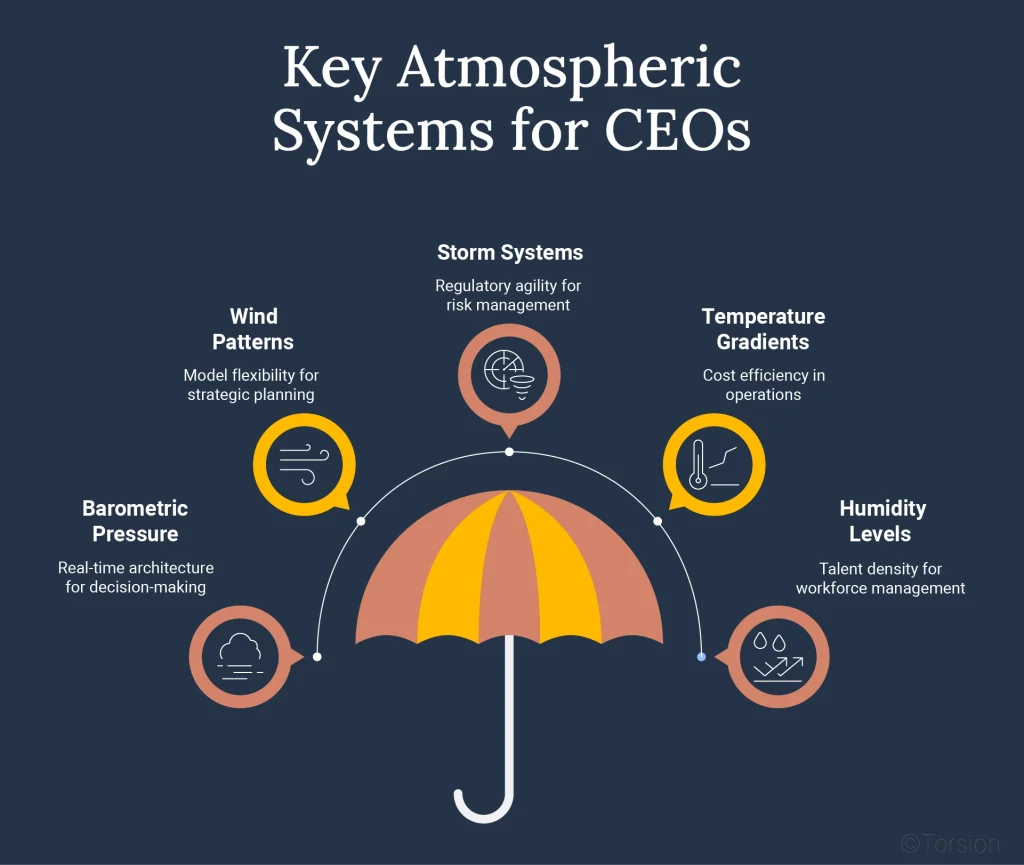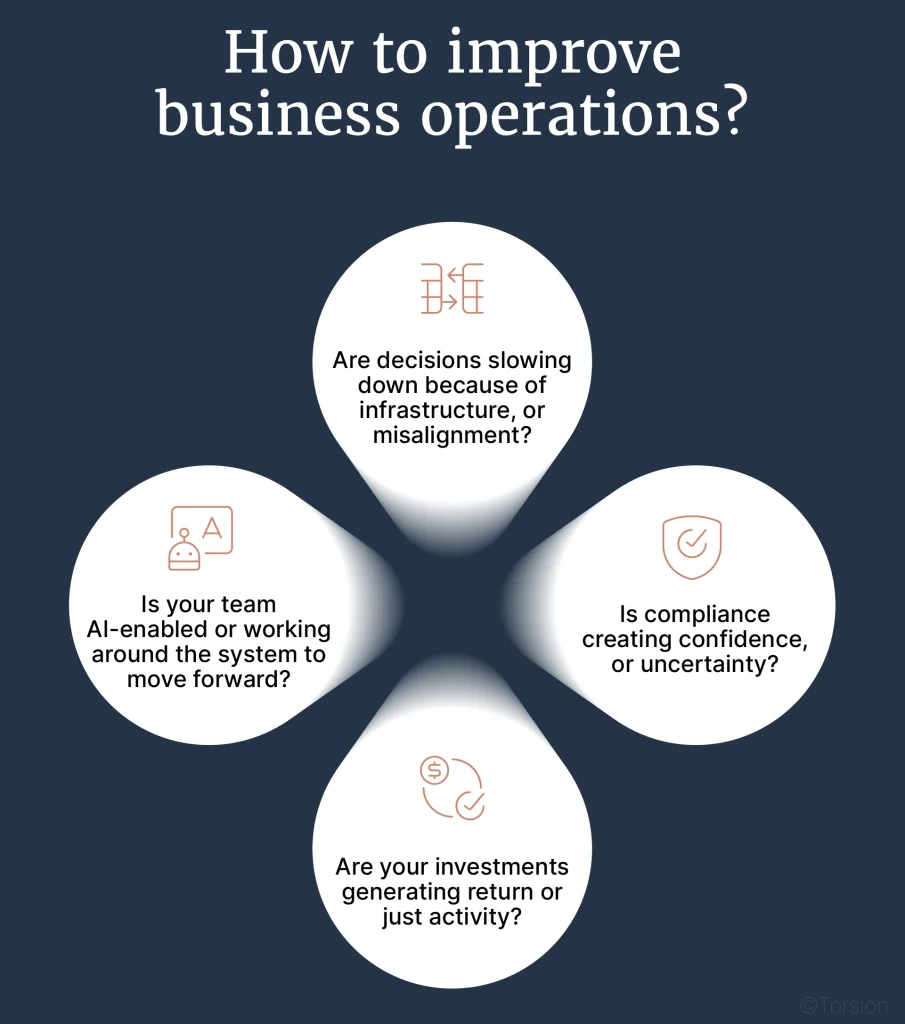Lately, I’ve noticed something shifting in the conversations I’m having with CEOs.
They’re not asking about models or infrastructure. They’re asking how to lead through change that doesn’t behave like anything they’ve seen before.
That tracks with what the data shows: CEOs now make more Enterprise AI decisions than CTOs. More importantly, it confirms something I’ve felt in the field for a while, that Enterprise AI is now a leadership decision rather than a technology decision.
The challenge is, most of the signals that matter at that level aren’t easy to measure. You feel them first, then pressure building inside teams, friction between functions, decisions slowing down when they should be speeding up.
That’s why we at Torsion started thinking about AI transformation more like the weather. Because like the weather, it builds. It creates pressure zones. And when it converges with other forces, regulation, cost, and customer expectations, you get a storm.
The Enterprise AI Weather Map was our way of helping CEOs read those signals before the disruption hits.
Because the earlier you see the system forming, the better chance you have of leading through it.
The Five Atmospheric Pressure Systems CEOs Must Monitor
Once we started thinking in weather systems, the patterns became easier to recognize.
Every organization we work with has pressure building somewhere, it just looks different depending on where they are in their journey. Some feel it in the systems. Others in governance. Almost everyone feels it in the org chart.
The Enterprise AI Weather Map breaks these patterns into five pressure systems. Together, they give CEOs a way to read the climate inside their business, not just the tooling around it.

Real-Time Architecture: Barometric Pressure
This is the foundation layer. When infrastructure supports real-time decision-making, things accelerate. When it doesn’t, delays stack up. You can feel the pressure rising in how long it takes to move from insight to action.
Model Flexibility: Wind Patterns
As organizations test more adaptive, agentic models, the winds shift. Some pick up speed by deploying, iterating, and learning. Others hit turbulence from rigid systems or siloed data. Direction matters, but so does resistance.
Regulatory Agility: Storm Systems
Well-designed compliance frameworks protect your momentum. They let you move fast with confidence. When they’re missing or outdated, policy changes hit like storms knocking teams off course.
Cost Efficiency: Temperature Gradients
Enterprise AI investments generate heat, attention, urgency, and spend. When that energy converts to ROI, it drives movement. When it doesn’t, it drags the system down. Warmth creates growth, but waste chills progress.
Talent Density: Humidity Levels
This is the human layer. Teams with concentrated Enterprise AI capability feel charged, decisions flow, blockers lift. Teams without that density feel heavy. It’s harder to get traction, harder to build momentum.
Each system tells part of the story. But together, they reveal how ready your organization really is, not just to start, but to sustain.
Reading Convergence Zones: Where Business Disruption Forms
Pressure systems by themselves tell you a lot. But the real signals start to show up where those systems collide.
I call these convergence zones the places where multiple forms of pressure meet. In healthcare payer organizations, I’m seeing them form around claims automation, compliance requirements, and real-time member experiences.
These challenges are structural collision points between customer expectations, regulatory shifts, and internal capabilities.
And this is where disruption tends to form.
Take the healthcare payer organizations operating in Dense Fog across at least one core Enterprise AI maturity dimension. That number doesn’t point to failure. It points to unread weather.
Many of these organizations do possess the required ambition or investment. They’re just navigating without visibility, making decisions in reactive mode rather than reading the signals early.
The organizations that lead in this space are doing something different. They’re using multi-dimensional weather intelligence to position ahead of the storm, while aligning technical readiness with operational velocity and regulatory agility. For them, talent and architecture are interdependent, not parallel tracks.
When you understand how these forces interact, you stop treating Enterprise AI as a tool, and start managing it like a system.
And that changes everything.
Your Executive Weather Station Dashboard
Once you start seeing where pressures converge, the next step is figuring out how to track them in real time.
That’s where the Enterprise AI Weather Map becomes more than a framework. It becomes a kind of weather station, built for CEOs who need a high-level view of where momentum is building, and where it’s stalling.
The map shows the technical gaps and also surfaces systemic signals:
- Are decisions slowing down because of infrastructure, or misalignment?
- Is compliance creating confidence, or uncertainty?
- Are your investments generating return or just activity?
- Is your team AI-enabled or working around the system to move forward?

You don’t need a perfect forecast to lead through this. You need visibility across the right dimensions, so you can respond with intent.
That’s what this eBook gives you.
It’s a better way to ask better, earlier so you can find the right answers sooner.
Navigation Tools for Clear Skies
Once you start seeing the signals clearly, the real work begins: deciding where to act and how fast.
Every organization has its own climate. Some face high pressure from legacy systems. Others feel the drag from fragmented governance or talent spread too thin. There’s no single playbook.
That’s why we wrote the Enterprise AI Weather Map to help leadership teams step back, read the broader conditions, and decide their next move with clarity.
If you’re leading through this shift and want to ground your strategy in what’s actually happening inside your organization, the map is a useful place to start.
Because once you understand your weather, you can navigate better.





